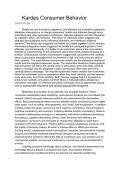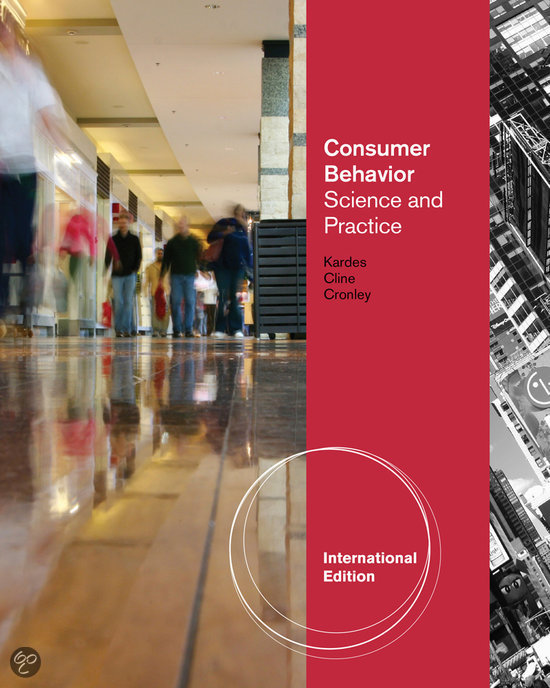Kardes Consumer Behavior
Summaries
Beliefs are non evaluative judgments, and attitudes are evaluative judgments.
Marketers frequently try to change consumers’ beliefs and attitudes through using
advertising and other persuasion techniques. Attitudes influence and are influenced
by cognition, affect, and behavior. The theory of reasoned action suggests that
attitudes and subjective norms influence intentions, and intentions influence
behavior. This theory also suggests that beliefs are added together to form attitudes.
Information integration theory suggests that beliefs are averaged together to form
attitudes, and consequently, it is better to tell consumers about a few very positive
features of a product than to tell consumers about many fairly positive features of a
product. Dual-process models of persuasion suggest that consumers think carefully
about a persuasive message when involvement is high and when they are able to
think carefully. The most famous dual-process models are the elaboration likelihood
model and the heuristic/systematic model. The elaboration likelihood model predicts
that consumers will follow the central route to persuasion when they think carefully
about a message and the peripheral route to persuasion when they don’t think
carefully about a message. The heuristic/systematic model predicts that consumers
follow the systematic route to persuasion when they think carefully, but the heuristic
route when they don’t think carefully. Both theories suggest that it is important to
predict how carefully consumers will think about a message before designing a
persuasive message. An effective persuasive message uses an appropriate source
and an appropriate argument and targets appropriate recipients.
Motivation and emotion focus attention and energize behavior. When
consumers desperately need something, goal-relevant products are overvalued (the
valuation effect) and goal-irrelevant products are undervalued (the devaluation
effect). Basic physiological needs must be satisfied before consumers pursue higher-
order goals, such as safety, belongingness, and, finally, self-actualization. In addition
to these needs and goals, consumers need cognitive consistency. Several types of
cognitive consistency are important, including attitude function consistency, balance
(consistent relationships among p-o-x elements), and behavior-attitude consistency.
According to cognitive dissonance theory, when behaviors and attitudes are
inconsistent, consumers are motivated to change their attitudes to make them
consistent with their behaviors. Positive affect increases helpfulness, creativity, and
the quality of decision making. Emotion is intense affect or affect plus arousal.
Exciting events, unexpected events, interruptions, exercise, and stimulants increase
arousal and intensify emotional experiences. Because consumers are bad at
interpreting their emotions without the help of contextual cues, one emotion can be
confused for another, and arousal produced by one stimulus can be transferred to
another.
Learning produces knowledge about products, and memory determines how
knowledge about products is accessed and used. Associations between
unconditioned and conditioned stimuli are learned via classical conditioning.
,Associations between responses and consequences are learned via operant
conditioning. Associations are the building blocks of knowledge stored in memory.
Although memory influences nearly all aspects of consumer behavior, most
consumers underestimate the importance of memory. The seven sins of memory are
side effects of an otherwise adaptive memory system. The sins of forgetting are
transience (forgetting over time), absent-mindedness (forgetting because of a lack of
effort during encoding or during retrieval), and blocking (forgetting as a result of
interference resulting from cue competition). The sins of distortion are misattribution
(distortion as a result of confusion), suggestibility (distortion as a result of the
questions and suggestions of others), and bias (distortion because of overestimating
the consistency of the past and the present, and vice versa). The sin of persistence
refers to the inability to forget what one wants to forget. Despite these sins, memory
enables consumers to perform remarkably complex thinking, reasoning, and
decision-making activities.
Automatic information processing refers to mental processes that occur
without awareness or intention, but that influence judgments, feelings, and
behaviors. Automatic information processing is useful and adaptive because it
enables people to perform some simple tasks without thinking. This allows people to
think more carefully about other tasks they need to perform. A response becomes
automatic via practice and repetition. One particularly useful skill that people have
learned automatically is thin-slice inferencing. Thin slices or brief observations of
another person’s behavior often tell us a surprisingly large amount of information
about the person. The priming effect is another important example of automatic
information processing. Recent or frequent exposure to an idea presented on
television, on the radio, in a magazine, in a book, or in a conversation can change
the way people think about subsequently encountered ambiguous information. An
unfamiliar product can seem expensive or inexpensive, versatile or easy to use, or
good or bad depending on what information was primed before examining the
product. Priming can also influence behavior as well as judgment. People often
behave in a manner consistent with the implications of a prime and do so without
awareness or intention.
Self-concept is the totality of an individual’s thoughts and feelings about him
or herself, including role identities, personal qualities, and self-evaluations. Role
identities represent the various positions that consumers occupy in society. Personal
qualities involve personality traits, or tendencies to behave in a certain way across
similar situations. Self-evaluations are constructed when consumers consider the
strength of their performances in various roles. The sum of all self-evaluations
comprises self-esteem, which is the overall evaluative component of self-concept.
The selfconcept can be broken down into two dimensions—the actual versus ideal,
each with two parts. The actual selfconcept represents how consumers perceive
themselves, while the actual public-concept embodies others’ true perceptions of a
consumer. The ideal self-concept describes how consumers would like to see
themselves, and the ideal public-concept represents how consumers would like
others to see them. Self-concept is important to marketers because consumers’ self-
,perceptions influence their attitudes towards products and subsequent purchase
behavior. If marketers want consumers to recall something about their brands, they
should create communications that are consistent with consumers’ actual self-
concepts. Alternatively, if marketers’ goals involve creating positive attitudes or
images about their brands, they should communicate information that is congruent
with consumers’ ideal self-concepts. The relationship between a consumer’s self-
concept and his/her possessions is called the extended self. Possessions for which
we develop a deep affection are known as “loved objects.” Loved objects can help
consumers resolve internal psychological conflicts. The term “malleable self” refers
to the notion that consumers can hold various self-concepts about themselves.
Consumers will employ a particular self-concept, depending on the situation and
their level of self- monitoring, which describes the extent to which consumers use
situational cues to guide their social behavior. People who change their behavior to
meet the expectations of others are known as high self-monitors, while people who
act primarily on the basis of their internal beliefs and attitudes are known as low self-
monitors. The process of creating contrived images for others is known as
impression management. Impression management involves our appearance,
ingratiation, and aligning actions. Consumers control their selection of clothes,
grooming, habits, language, and possessions. Ingratiation is the purposeful attempt
to gain benefits or favors from others. Aligning activities are attempts to realign our
behavior so it comes close to matching norms. A consumer’s personality consists of
a set of unique psychological characteristics that influence thoughts, feelings, and
behavior regarding products and services. Multiple trait theory holds that individuals’
personality traits describe their tendencies to respond in given ways across similar
situations. Brands also have personalities, comprised of the human characteristics
we associate with them. Brand personalities are derived from the typical user, typical
use situation, product associations, and brand characterization. Personality
differences can affect consumers’ motivation to respond favorably to marketing
activities and brands. Need for cognition (NFC) describes a consumer’s tendency to
engage in and enjoy effortful cognitive activities. Need for humor (NFH) represents
an individual’s inclination to crave and engage in humor. Finally, need for cognitive
closure (NFCC) explains a consumer’s desire for any kind of knowledge that reduces
confusion or ambiguity.
This chapter focused on how consumers recognize problems, define their
markets, gather information related to their consideration and purchase decisions,
and determine their satisfaction. Consumer decision making can be defined by the
amount of effort people exert to solve a problem. Routine response behavior
involves minimal effort, intermediate problem solving entails mid-level effort, and
extensive problem solving requires a great deal of effort. Consumer decision making
can also be characterized as a joint function of processing effort and involvement,
which creates four distinct types of decisions. When both involvement and
information processing are low, consumers typically make choices as a matter of
habit, or exhibit brand laziness, as opposed to a fundamental commitment to the
brand. When consumer involvement is high and information processing is low,
, consumers exhibit brand loyalty, an intrinsic commitment to a brand based on the
benefits or values it provides consumers. When consumers experience low
involvement and high information processing, they exhibit variety seeking behavior,
the desire to choose new alternatives over more familiar ones—just for the sake of
change. Finally, when both involvement and information processing are high,
consumers engage in genuine problem-solving strategies. Because consumers
cannot consider all the features of a brand, they must identify one or more
determinant attributes, characteristics of a product that are both important and
unique, and thus, most likely to affect the buyer’s choice. Problem solving is the
focus of the traditional model of consumer decision making because the decision
involves relatively high levels of risk. The traditional model of consumer decision
making involves five stages of consumer problem solving. Problem recognition takes
place when consumers experience a disparity between what they have and what
they want. This is known as a want-got gap. Needs, wants, and opportunities trigger
problem solving. Information search involves both the active and passive processing
of data aimed at solving the problem. The level of search is determined by consumer
involvement, the marketing environment, situational influences, and individual
differences. Evaluation of alternatives requires consumers to determine which
product attributes are important and which brands to evaluate on the basis of these
attributes. Purchase decisions represent consumers’ predispositions or intentions to
buy a brand. Finally, during post-purchase evaluation, consumers compare their
perceptions of a brand with their expectations and determine their satisfaction. The
uncertainty-reduction model of Consumer Decision Making recognizes that
consumers can only make rational decisions within the limits of time and cognitive
capability. This approach to decision making involves four stages that specifically
deal with consumers’ bounded rationality. First, consumers develop perceptions of
what the product-market looks like. Next, they whittle down the vast number of
brands into a single subset of brands for consideration. Then, consumers choose
one brand from the consideration set. Finally, based on their consumption
experiences, consumers adjust their perceptions of product-markets in an attempt to
make better future decisions. This model emphasizes that consumers continuously
sort out and manage information about their chosen brands in an attempt to reduce
uncertainty. One of the ways that consumers evaluate their purchases is by
assessing their satisfaction. A popular strategy that consumers use to assess their
satisfaction is to compare the chosen brand with a rejected alternative. This strategy
is known as dissonance-reduction. Another way consumers determine satisfaction is
by comparing a brand’s performance against expectations of that performance. If the
performance equals expectations, then consumers are satisfied. If it exceeds
expectations, consumers are delighted. And if the brand fails to live up to
expectations, people become dissatisfied.
Consumer choice involves choosing one brand from a set of products. The set
of products that consumers think about and evaluate—the consideration set—usually
consists of fewer than seven brands, and the best brand is not always included in the
consideration set. The more consumers think about some brands, the more difficult it





